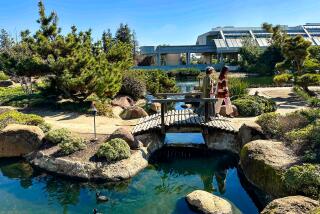How to Build a Lake : The Making of Hansen Dam Recreation Area
- Share via
Work began in January on a 10.5-acre fishing, boating and swimming lake system in Lake View Terrace that will restore a major outdoor attraction to the Hansen Dam Recreation Area by October 1996.
Many Valley residents fondly remember weekends spent on the shores of Holiday Lake, a 120-acre body of water used by water-skiers, fishers, boaters and swimmers that had formed naturally behind Hansen Dam in a large excavation pit. Heavily used since 1952, Holiday Lake eventually became choked by silt and sediments after major floods, and by 1983, the lake was filled.
Through a joint effort between the city of Los Angeles and the U.S. Army Corps of Engineers, $10 million in funds were allocated in 1994 for construction of a pair of new lakes to be located on the north side of the recreation area, on higher ground near Foothill Boulevard. The Army Corps owns the land but leases it to the city for recreation purposes.
The design of the 1.5-acre swimming lake resembles a large pool, with a concrete bottom, sandy beach and a gently graded access ramp for the disabled. Next to it, a larger, nine-acre boating and fishing lake will include a boat launch for canoes and other non-motorized vessels.
1: Digging the Base
The first six months of construction will be consumed by the removal of more than 200,000 cubic yards of silt and sand and compacting of the lake banks.
2: Installing the Lake Bed
Once the lake beds have been dug and prepared, concrete and clay liners are poured. The liners maintain water clarity and quality and allow easy filtration and recirculation.
3: Filling the Lakes
Using water supplied by a well to be drilled near the lake and from city aquifers, engineers will fill the two lakes with a total of almost 32 million gallons of water.
4: Making a Splash
Finishing touches will include picnic benches, landscaping, car and boat parking lots, restrooms, lifeguard stands, fishing docks and a boat launch.
Sources: U.S. Army Corps of Engineers; Robert Bein, William Frost & Associates
Researched by TIM MAY / For The Times
More to Read
Sign up for Essential California
The most important California stories and recommendations in your inbox every morning.
You may occasionally receive promotional content from the Los Angeles Times.













